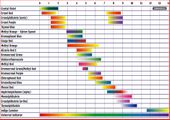Difference between revisions of "PH indicator"
(→Phenolphthalein) |
|||
| Line 32: | Line 32: | ||
=== [[Bromocresol purple]] === | === [[Bromocresol purple]] === | ||
This indicator is unusual in that it is somewhat acidic itself, and orange-yellow in its pure form. However, when the pH turns to neutral or higher, it turns purple. It usually comes as a solid. Bromocresol purple is very useful in acid-base titrations, because its pronouncedly purple form comes to existence at pH precisely 7, which allows for very precise measurements. First it turns crimson, and when you add more base, it becomes purple. The crimson color, corresponding to pH 7, signals the end of the titration. | This indicator is unusual in that it is somewhat acidic itself, and orange-yellow in its pure form. However, when the pH turns to neutral or higher, it turns purple. It usually comes as a solid. Bromocresol purple is very useful in acid-base titrations, because its pronouncedly purple form comes to existence at pH precisely 7, which allows for very precise measurements. First it turns crimson, and when you add more base, it becomes purple. The crimson color, corresponding to pH 7, signals the end of the titration. | ||
| + | |||
| + | ==Gallery== | ||
| + | <gallery widths="200" position="center" columns="4" orientation="none"> | ||
| + | PH indicator colors and ranges chart.jpg|A chart showing the ranges and colors of common pH indicators | ||
| + | </gallery> | ||
==See also== | ==See also== | ||
Revision as of 22:33, 24 December 2023
 |
This article is a stub. Please help Sciencemadness Wiki by expanding it, adding pictures, and improving existing text.
|
pH indicators are compounds that change color depending on the pH of the solution they are in. This property of theirs is widely used in labs to measure pH.
Contents
Common indicators
Litmus
Litmus is a complex mixture of plant dyes, discovered back in the days of alchemists. Litmus turns red in low pH, purple in neutral pH, and blue in high pH. Modern litmus paper strips are no longer based on natural dyes, they are impregnated with litmoid, or 7-hydroxyphenoxazone, which is produced artificially. Litmoid is available as paper strips, solution or dry solid.
Universal indicator
The most common modern indicator strips are impregnated with a mixture of dyes which allows very precise measuring of pH. Generally, universal indicator strips are red in low pH, yellow or green in neutral pH and blue in high pH, but there is a hue corresponding to every integer meaning of pH. Universal indicator is available as paper strips. A somewhat crude version of universal indicator can be prepared by mixing thymolphthalein and methyl red.
Anthocyanin
An easily obtained replacement for litmus, anthocyanin can be extracted from various food products, but the best one comes from hibiscus herbal tea (marketed under names such as "Flor de Jamaica", "Karkade", "Italian Tea" or "Red Zinger"), extracted with ethanol. It is red in very low pH, pink in low pH, purple in neutral pH, green in high pH and greenish-yellow in very high pH. It can also be made from red cabbage, but such an extract is inferior, because cabbage contains a lot of water, which goes into the extract and makes it less stable. Paper strips can be easily made from an alcohol extract of anthocyanin, or it can be used as a solution.
Phenolphthalein
An indicator for bases, the colorless phenolphthalein turns rose, pink or crimson in high pH. Extremely high pH causes it to become colorless again. Several decades ago, it was in common use as an over-the-counter laxative, which guaranteed easy access to this indicator for amateur chemists. Currently, it is no longer sold in drugstores. Phenolphthalein is usually available as a solution or crystalline solid, rarely paper strips.
Very similar to phenolphthalein are its closest relatives, thymolphthalein, naphtholphthalein and cresolphthalein. These colorless indicators turn blue, cyan and red respectively in high pH. They do not lose color in extremely high pH.
Curcumin
An over-the-counter replacement for phenolphthalein, the yellow curcumin turns red in high pH. It can be extracted from inexpensive spices such as turmeric or "curry mix". Do not use curcumin in solutions that contain the borate ion, because it gives a false positive with curcumin. Curcumin can be used as a liquid extract, or paper strips can be made from it.
Uncommon indicators
Methyl orange
An indicator for acids, methyl orange changes its color to red in very low pH. It is available as paper strips, solution or solid.
Crystal violet
Also an indicator for acids, crystal violet allows distinguishing strong, mid-strength and weak acids. Strong acids make this intensely violet dye turn yellow, mid-strength or very dilute strong acids turn it green or blue, and weak acids do not change its color. It usually comes as a solid.
Bromocresol purple
This indicator is unusual in that it is somewhat acidic itself, and orange-yellow in its pure form. However, when the pH turns to neutral or higher, it turns purple. It usually comes as a solid. Bromocresol purple is very useful in acid-base titrations, because its pronouncedly purple form comes to existence at pH precisely 7, which allows for very precise measurements. First it turns crimson, and when you add more base, it becomes purple. The crimson color, corresponding to pH 7, signals the end of the titration.
